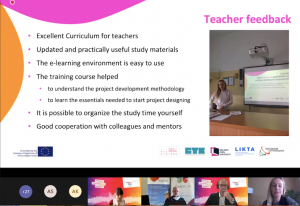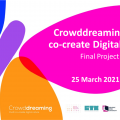
19 Oct “Learn how to Crowddream” – CDDC workshop at the ALL DIGITAL Summit
19 Oct, 2020
 The art of Crowddreaming (CDDC) is a methodology that connects young people and educators with cultural heritage and digitalisation in a unique co-creation process that contributes to the common understanding of the European history and values, intercultural dialogue and mutual understanding.
The art of Crowddreaming (CDDC) is a methodology that connects young people and educators with cultural heritage and digitalisation in a unique co-creation process that contributes to the common understanding of the European history and values, intercultural dialogue and mutual understanding.
It is one of those things that are simple yet complicated. If questions like How do I dream in the crowd? Do I do that only by night? What do educators (teachers and trainers) have to do with it? How does that help me understand our history and values? popped up after reading the first paragraph you have to finish the article. Everything will be clear by the time you reach the end. One more thing, we have all been there and we understand your temporary confusion.
To solve the mystery of Crowddreaming and inspire educators (teachers and trainers) across the continent to join us in creating a digital European monument that will give tribute to the various cross-cultural influences on the unique digital monument called Europe Square the project partners of Crowddreaming: Youth co-create digital culture project organized a workshop at ALL DIGITAL Summit 2020.
The workshop started with a presentation by Paolo Russo from Stati Generali dell’Innovazione (Italy) on the idea and philosophy behind Crowddreaming. Participants learned from Paolo that the result of Crowddreaming project will be the Europe Square which is a digital thanksgiving monument that will have at least 80 AR (augmented reality) installations across Europe (check the virtual tour demo of the Europa Square here). Each installation (or a thanksgiving shrine as we also call it) is built around a thank you message from people of one European country to another for their contribution to their culture. Paolo also explained the WHY and WHAT of Crowddreaming methodology and explained the idea behind it. To learn more about it you are invited to watch Paolo’s presentation here.

Now that you understand the basics of Crowddreaming, let’s move to the “HOW to do it” part. This represents the core of the CDDC project. To enable the implementation of The Art of Crowddreaming methodology, project partners developed:
- Methodology Handbook
- Training Toolkit and pedagogical framework
- Curriculum based on open educational resources (OERs)
- A MOOC to equip the educators (teachers and trainers) with competencies required to guide and support young people in creating their thanksgiving shrines.
Arnita Vaitkus from LIKTA (Latvia) presented the Training Toolkit and Curriculum for teachers which were developed to raise educators’ awareness about the cultural heritage and prepare them to provide support to young people in developing digital cultural heritage projects (thanksgiving shrines). Documents contain a training plan, OERs (free tools, examples and templates) and learning outcomes. Learn more about the content of the documents and what teachers think about them by watching Arnita’s presentation here.
Vicky Marotou from Hellenic Open University (Greece) introduced the MOOC that was created to implement the Curriculum and provide educators with competencies needed to use the Crowddreaming methodology in working with young people from the age of 11 -18 years. The MOOC is divided into 6 learning modules that take 26 hours to complete. It is designed to take 12 weeks and is available in English, Croatian, Greek, Italian and Latvian language. Currently, the MOOC is not accessible because project partners are upgrading it to incorporate feedback and suggestions from educators that completed it during the piloting phase. When this will be done, it will be available without any charges to everyone. Learn more about the MOOC modules, tests and learning materials used from Vicky’s presentation that you can watch here.
 The WHY, WHAT and HOW are all very important cogs of the Crowddreaming mechanism and something that the CDDC project partners have been developing in the first year of the project. But the real power of the Crowddreaming methodology is revealed when all the pieces come together.
The WHY, WHAT and HOW are all very important cogs of the Crowddreaming mechanism and something that the CDDC project partners have been developing in the first year of the project. But the real power of the Crowddreaming methodology is revealed when all the pieces come together.
Sanjin Smajlović from CTK Rijeka (Croatia) presented the process of implementing Crowddreaming methodology in practice. The piloting of the Crowddreaming took place in 4 countries (Croatia, Greece, Italy and Latvia) where 400 students attended 80 workshops under the guidance and mentorship of their teachers to create 80 digital scenes for Europea Square platform. The process of creating digital scenes/thanksgiving shrines is divided into 4 phases: (1) Research, (2) Discussion, (3) Creation and (4) Delivery. Additional tools like action plans and coaching circles were used to support this process. Final results come in various forms – a slideshow, video, audio, computer game, web page, infographic, etc. Watch Sanjin’s presentation to learn in detail how the digital scenes are created here.
The workshop was concluded by input from Eric Ballhausen from the European Commission’s Executive Agency EACEA that manages the Erasmus+ programme centralized calls for funding. Eric presented how the programme contributes to the social inclusion in Europe and how the projects like CDDC complement the work of the European Union in this field. You can learn more by watching Eric’s presentation here.
Crowddreaming: Youth co-create digital culture has reached its final stage where everything that was presented at the workshop is coming together. As most of the projects, businesses, organisations and institutions across Europe, it was also severely impacted by COVID-19 containment measures, which altered the original timeline of the deliverables. However, the motivation of teachers and students working on the digital scenes is great, and our Europea Square will be populated by at least 80 digital scenes/thanksgiving shrines by the end of 2020.
Follow the project Facebook page so you don’t miss the launch of Europa Square and other information about the project.









